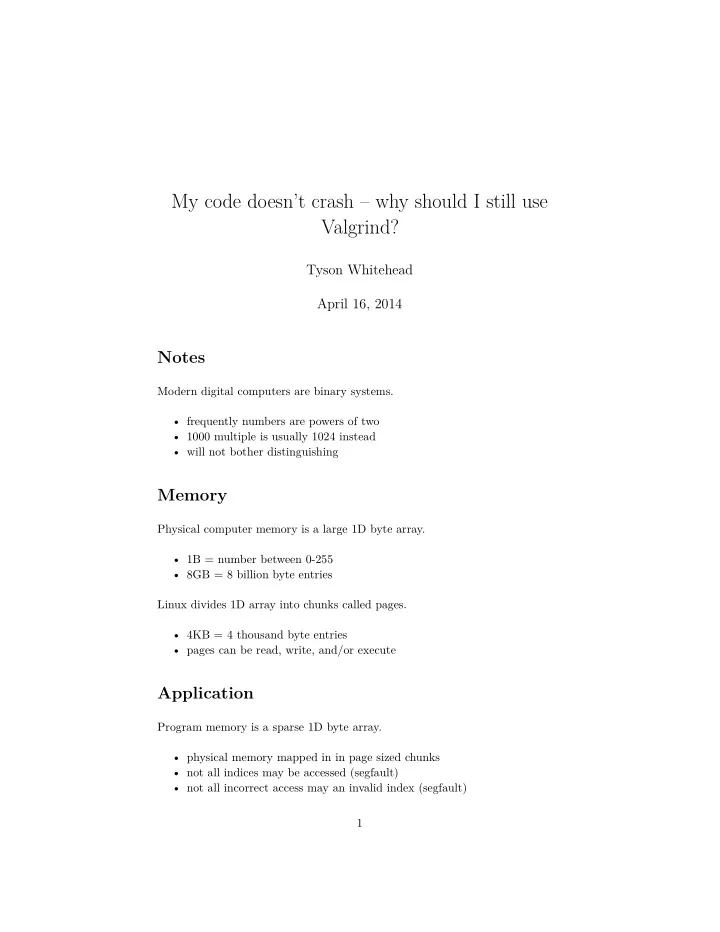

My code doesn’t crash – why should I still use Valgrind? Tyson Whitehead April 16, 2014 Notes Modern digital computers are binary systems. • frequently numbers are powers of two • 1000 multiple is usually 1024 instead • will not bother distinguishing Memory Physical computer memory is a large 1D byte array. • 1B = number between 0-255 • 8GB = 8 billion byte entries Linux divides 1D array into chunks called pages. • 4KB = 4 thousand byte entries • pages can be read, write, and/or execute Application Program memory is a sparse 1D byte array. • physical memory mapped in in page sized chunks • not all indices may be accessed (segfault) • not all incorrect access may an invalid index (segfault) 1
Diagram Figure 1: Physical memory Layout Program memory (1D byte array) broken up into • null catch area (unmapped) • code (read/execute) • constant data (read) • mutable data (read/write) • heap (read/write) • code, constant and mutable data for libraries • stack (read/write) • kernel interface (read/execute) Linux does not care as long as index is valid for operation executable layout readelf -t EXE process layout cat /proc/ PID /maps 2
Diagram Figure 2: Program memory Heap Area of read/write memory for dynamic memory allocation • expanded by mapping new pages to bottom • managed by GNU C library (glibc) via malloc and free • includes records for tracking allocations • allocating and releasing leaves holes What can go wrong • allocating without releasing will eventually exhaust memory • releasing non-allocated memory will mess up glibc • invalid reads will return other data unless outside entire region • invalid writes will overwrite other data unless outside entire region • other data includes glibc memory management structures source of problem may not be where program dies 3
Diagram Figure 3: Heap memory Stack Area of read/write memory for handling function calls • expanded by mapping new pages to top • addresses of calling function for return • arguments passed to functions • local variables used by functions What can go wrong • invalid reads will return other data unless outside entire region • invalid writes will overwrite other data unless outside entire region • other data includes return addresses source of problem may not be where program dies 4
Diagram Figure 4: Stack memory Valgrind Dynamic binary instrumentation framework • dynamically translates executables to add instrumentation • tracks all memory and register usages by a program memcheck memory error detector cachegrind cache and branch-prediction profiler callgrind call-graph generating cache and branch prediction profiler helgrind thread error detector DRD thread error detector Massif heap profiler DHAT dynamic heap analysis tool SGCheck experimental stack and global array overrun detector BBV experimental basic block vector generation tool 5
Usage Advantages • can be directly run on any executable • dynamic translation allows ultimate instrumentation Disadvantages • 5-100 x slow down depending on tool • 12-18 x increase in size of translated code • corner cases may exist between translated code and original run on small test cases – can save hours and hours of debugging MemCheck Default valgrind tool that detect several common memory errors • overrunning and underrunning heap blocks • overrunning top of stack • continuing to access released memory • using uninitialized values • incorrectly using memory copying routines • incorrectly paired allocation/release calls • relasing unallocated memory • not releasing memory 6
Recommend
More recommend